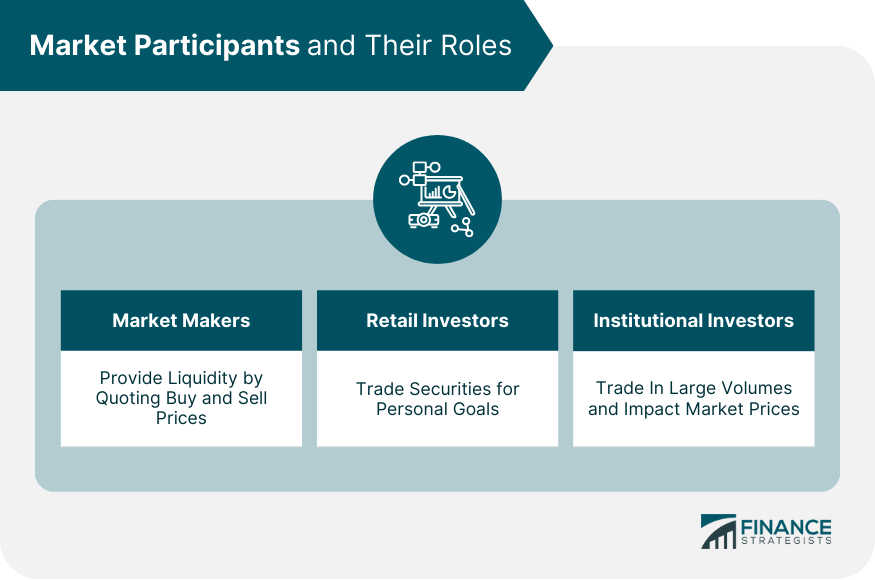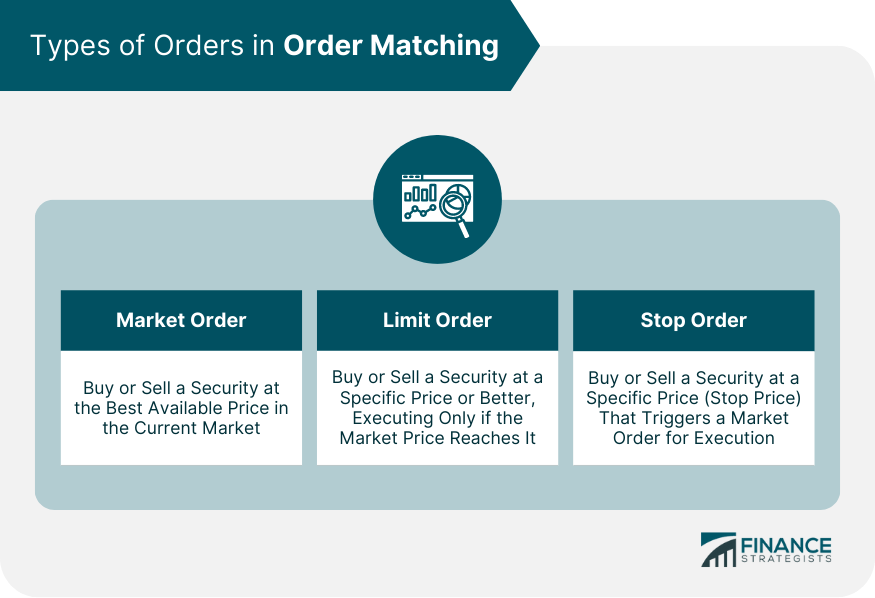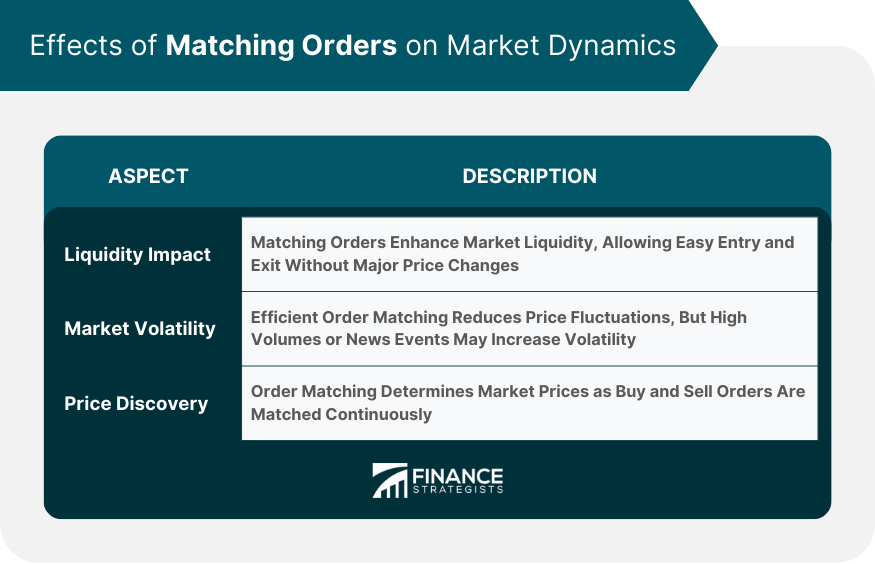Matching orders refers to the process by which buy and sell orders for a specific security are paired in a trading system. This system is often managed by a stock exchange or a matching engine in an electronic trading platform. The matching of orders is a vital cog in the wheel of financial markets, ensuring the continuity and efficiency of trades. Matching orders is a core mechanism that enables the smooth functioning of financial markets. It facilitates the process of price discovery, aids in maintaining liquidity, and ensures the fair execution of trades. In essence, it allows a buyer and a seller to transact efficiently, thereby contributing to market stability. An order book is a real-time list of buy and sell orders for a particular security arranged by price level. It provides a snapshot of market demand for security at various price levels, both above (asks) and below (bids) the current market price. An order book is crucial to the order-matching process, as it is the source from which orders are matched. Orders are typically listed on the order book based on their price and time of submission. Buy orders (bids) are arranged in descending order, with the highest bid at the top, while sell orders (asks) are arranged in ascending order, with the lowest ask at the top. The difference between the highest bid and the lowest ask is known as the spread. Market makers are firms or individuals who provide liquidity to the market by continually offering to buy and sell securities at publicly quoted prices. By doing so, they facilitate smoother order matching by reducing the time it takes to find a buyer or seller. Retail investors are individuals who buy and sell securities for their personal accounts, not for a company or organization. They contribute to the diversity of the market and, thus, to the robustness of the order-matching process. Institutional investors are entities such as mutual funds, pension funds, and insurance companies that trade in large volumes. Their large orders often influence the dynamics of order matching and can impact market prices. A market order is a type of order where an investor decides to buy or sell a security at the best available price in the current market. It is the fastest way to place a trade and is likely to be executed because it does not contain restrictions on the price or the time frame in which the trade can occur. A limit order is an order to buy or sell a security at a specific price or better. Unlike a market order, a limit order is not guaranteed to execute. It will only fill if the market price reaches the limit price set by the trader. A stop order, also known as a stop-loss order, is an order to buy or sell a security once it reaches a particular price, known as the stop price. Once the stop price is reached, the stop order becomes a market order and is executed at the best available price. A matching engine is a digital system used in stock exchanges and electronic trading platforms to match buy and sell orders. It uses algorithms to compare incoming orders with those already in the order book and matches them based on specific criteria, such as price and quantity. The matching engine plays a critical role in order matching. It ensures that trades are executed fairly and efficiently by adhering to predetermined rules, which aim to ensure the best execution possible for all market participants. Without a matching engine, the process of finding a counterparty for each trade would be significantly slower and less efficient. The price-time priority algorithm is one of the most commonly used in order matching. It prioritizes orders based on price first and then by the time of order submission. The highest bid or the lowest ask gets matched first. If two orders have the same price, the one entered earlier gets priority. The pro-rata algorithm is another method used for order matching, particularly in futures markets. It distributes orders based on their price and size. All orders at the best price are filled proportionally based on their size. Market orders are typically the first to be matched since they do not contain any price restrictions. They are matched with the best available opposing order on the order book, i.e., a buy market order will match with the lowest available sell order and vice versa. Limit orders are matched based on their specified limit price. A buy limit order will be matched with a sell order of the same price or lower, while a sell limit order will match with a buy order of the same price or higher. However, these orders will only execute if the market price reaches the specified limit price. If the market price does not reach the limit price, the order remains unfilled on the order book. Matching orders greatly influence the liquidity of a market. A vibrant and efficient order-matching system ensures that there are enough buy and sell orders at any given time, contributing to a liquid market. A liquid market allows traders to enter and exit positions easily without causing significant price changes. Matching orders also affect market volatility. Efficient order-matching processes can help absorb market shocks and minimize price fluctuations by quickly matching buy and sell orders. However, in cases of high trading volumes or significant news events, the order-matching process may struggle to keep pace, leading to increased market volatility. Order matching is integral to the price discovery process in financial markets. As buy and sell orders are matched, the agreed-upon prices become the new market prices for the respective securities. This process, repeated continuously throughout the trading day, facilitates the discovery of fair market prices. Financial regulatory bodies oversee the order-matching process to ensure market fairness and transparency. These bodies, such as the Securities and Exchange Commission (SEC) in the U.S., establish rules and regulations that exchanges and electronic trading platforms must adhere to. Common regulations governing order matching include best execution obligations, which mandate brokers to obtain the best possible price for their client's orders. There are also rules against manipulative practices like spoofing, where traders place orders with the intention of canceling them to manipulate prices. There is always a risk of failed matches in order matching. This can occur due to reasons such as insufficient market liquidity or technological glitches. Order-matching systems can be susceptible to manipulative practices such as spoofing and layering. Regulatory bodies continuously monitor and adapt to these threats to maintain market integrity. Technological risks, such as system failures, data breaches, or cyberattacks, pose significant challenges to electronic order-matching] systems. Order matching plays an indispensable role in financial markets by ensuring efficient and fair trade execution. It uses a digital system called a matching engine that employs algorithms to pair buy and sell orders. The process takes into account different types of orders - market, limit, and stop orders. This system not only bolsters market liquidity but also significantly impacts market volatility and price discovery. It's subject to regulations laid out by financial bodies like the SEC, ensuring market fairness and transparency. While technological advancements have greatly enhanced the speed and efficiency of order matching, they bring risks such as failed matches, market manipulation, and cybersecurity threats. Understanding the intricacies of order matching is vital for market participants as it shapes the dynamics of financial markets.What Are Matching Orders?
Basics of Order Matching
Order Book
Understanding the Order Book
How Orders Are Listed on the Order Book
Market Participants and Their Roles
Market Makers
Retail Investors
Institutional Investors

Types of Orders in Order Matching
Market Orders
Limit Orders
Stop Orders

Process of Matching Orders
Matching Engine
Order Matching Algorithms
Price-Time Priority
Pro-rata
How Orders Are Matched
Market Orders
Limit Orders
Effects of Matching Orders on Market Dynamics
Impact on Liquidity
Impact on Market Volatility
Impact on Price Discovery

Regulations Governing Order Matching
Role of Financial Regulatory Bodies
Common Regulations and Compliance
Risks and Challenges in Order Matching
Risk of Failed Matches
Market Manipulation Risks
Technological Risks
Final Thoughts
Matching Orders FAQs
Matching orders in financial markets is designed to pair buy and sell orders efficiently, facilitating trades and contributing to market liquidity and price discovery.
Matching orders can help minimize market volatility by quickly pairing buy and sell orders. However, during times of high trading volume or significant news events, the process may struggle to keep pace, potentially leading to increased volatility.
The matching orders process involves various types of orders, including market orders, limit orders, and stop orders.
Risks associated with matching orders include the potential for failed matches, manipulative market practices, and technological risks such as system failures or cyberattacks.
Technology, particularly the advent of electronic trading, has greatly enhanced the efficiency of the order-matching process. High-frequency and algorithmic trading further rely on efficient order matching, while future advancements may include artificial intelligence and blockchain technology.
True Tamplin is a published author, public speaker, CEO of UpDigital, and founder of Finance Strategists.
True is a Certified Educator in Personal Finance (CEPF®), author of The Handy Financial Ratios Guide, a member of the Society for Advancing Business Editing and Writing, contributes to his financial education site, Finance Strategists, and has spoken to various financial communities such as the CFA Institute, as well as university students like his Alma mater, Biola University, where he received a bachelor of science in business and data analytics.
To learn more about True, visit his personal website or view his author profiles on Amazon, Nasdaq and Forbes.











